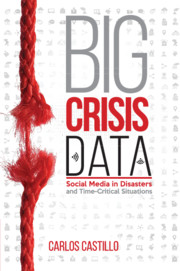Book contents
- Frontmatter
- Contents
- Preface
- Acknowledgments
- 1 Introduction
- 2 Volume: Data Acquisition, Storage, and Retrieval
- 3 Vagueness: Natural Language and Semantics
- 4 Variety: Classification and Clustering
- 5 Virality: Networks and Information Propagation
- 6 Velocity: Online Methods and Data Streams
- 7 Volunteers: Humanitarian Crowdsourcing
- 8 Veracity: Misinformation and Credibility
- 9 Validity: Biases and Pitfalls of Social Media Data
- 10 Visualization: Crisis Maps and Beyond
- 11 Values: Privacy and Ethics
- 12 Conclusions and Outlook
- Bibliography
- Index
- Terms and Acronyms
11 - Values: Privacy and Ethics
Published online by Cambridge University Press: 05 July 2016
- Frontmatter
- Contents
- Preface
- Acknowledgments
- 1 Introduction
- 2 Volume: Data Acquisition, Storage, and Retrieval
- 3 Vagueness: Natural Language and Semantics
- 4 Variety: Classification and Clustering
- 5 Virality: Networks and Information Propagation
- 6 Velocity: Online Methods and Data Streams
- 7 Volunteers: Humanitarian Crowdsourcing
- 8 Veracity: Misinformation and Credibility
- 9 Validity: Biases and Pitfalls of Social Media Data
- 10 Visualization: Crisis Maps and Beyond
- 11 Values: Privacy and Ethics
- 12 Conclusions and Outlook
- Bibliography
- Index
- Terms and Acronyms
Summary
“This is the paradox: effective response in the ‘Networking Age’ requires open data and transparency, but the more information that is shared the more risks and challenges for privacy and security emerge” (UN OCHA, 2014a). Disasters and emergencies create situations of vulnerability for affected populations that often leave them more exposed to harm. There are many ways in which data scientists and analysts can do harm, for instance, by exposing the private lives of people, or by putting response operations in danger.
Privacy and security concerns should not be used as a reason not to apply new communication technologies during emergencies, but they should be taken into account (UN OCHA, 2012). At a high level, researchers and practitioners need to find the right spot between full opacity and full transparency, finding a balance between security concerns and operational needs. Given their risk aversion, it may be impossible to engage with some organizations, particularly the ones that operate at a national level or at an international level, without some formal agreements in place, particularly related to personal data protection standards.
Social media brings more complexity to emergency and disaster situations by reducing the amount of control that responders and relief workers have. For instance, emergency incident scenes have traditionally been delimited and closed by barriers such as the proverbial “yellow tape” used by the police in many countries. Social media and mobile phone cameras can nearly evaporate this traditional scene control (Crowe, 2012, ch. 5). Rescue personnel, including firefighters, police officers, and others who physically converge on the scene have responsibility and legal codes to respect. As the public also enters the scene (physically or virtually), they must adhere to ethical standards they may be unfamiliar with. Technology can be used to weaken or to strengthen those standards.
This chapter is an attempt to highlight some of the ethical concerns around processing social media data during emergencies. Some of these concerns have elicited some degree of self-regulation, for instance, in the form of ethical guidelines, while others have not.
We startwith widely agreed-upon areas in which the practitioner community has already developed some guidance, including privacy (§11.1) and human conflict (§11.2). Then, we venture into territory where the questions are newer and hence less guidance can be provided, such as the protection of digital volunteers (§11.3), and issues related to experimentation (§11.4) and data sharing (§11.5).
- Type
- Chapter
- Information
- Big Crisis DataSocial Media in Disasters and Time-Critical Situations, pp. 152 - 163Publisher: Cambridge University PressPrint publication year: 2016



